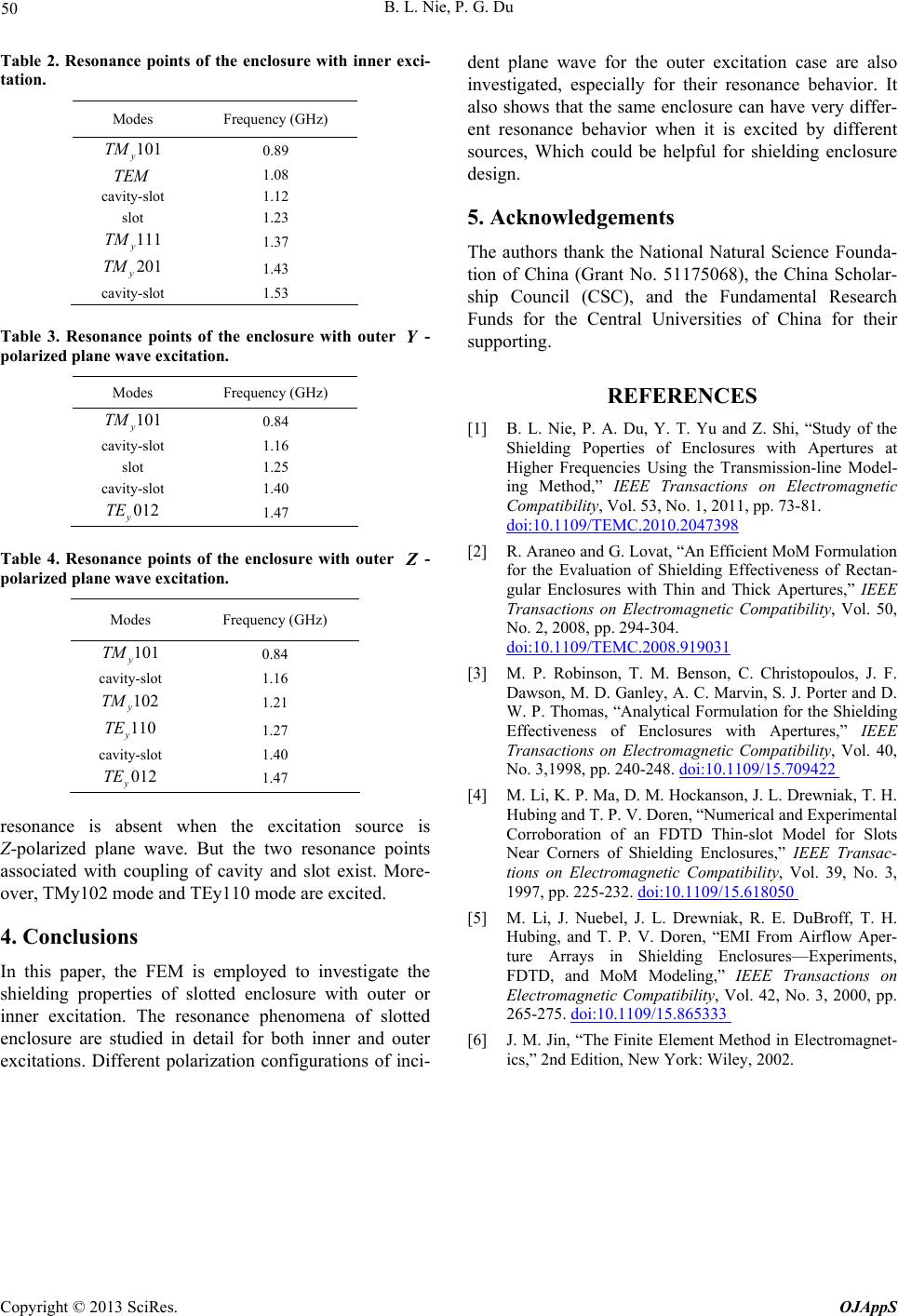
B. L. Nie, P. G. Du
Copyright © 2013 SciRes. OJAppS
50
Table 2. Resonance points of the enclosure with inner exci-
tation.
Modes Frequency (GHz)
101
y
TM 0.89
TEM 1.08
cavity-slot 1.12
slot 1.23
111
y
TM 1.37
201
y
TM 1.43
cavity-slot 1.53
Table 3. Resonance points of the enclosure with outer -
polarized plane wave excitation.
Y
Modes Frequency (GHz)
101
y
TM 0.84
cavity-slot 1.16
slot 1.25
cavity-slot 1.40
012
y
TE 1.47
Table 4. Resonance points of the enclosure with outer -
polarized plane wave excitation.
Z
Modes Frequency (GHz)
101
y
TM 0.84
cavity-slot 1.16
102
y
TM 1.21
110
y
TE 1.27
cavity-slot 1.40
012
y
TE 1.47
resonance is absent when the excitation source is
Z-polarized plane wave. But the two resonance points
associated with coupling of cavity and slot exist. More-
over, TMy102 mode and TEy110 mode are excited.
4. Conclusions
In this paper, the FEM is employed to investigate the
shielding properties of slotted enclosure with outer or
inner excitation. The resonance phenomena of slotted
enclosure are studied in detail for both inner and outer
excitations. Different polarization configurations of inci-
dent plane wave for the outer excitation case are also
investigated, especially for their resonance behavior. It
also shows that the same enclosure can have very differ-
ent resonance behavior when it is excited by different
sources, Which could be helpful for shielding enclosure
design.
5. Acknowledgements
The authors thank the National Natural Science Founda-
tion of China (Grant No. 51175068), the China Scholar-
ship Council (CSC), and the Fundamental Research
Funds for the Central Universities of China for their
supporting.
REFERENCES
[1] B. L. Nie, P. A. Du, Y. T. Yu and Z. Shi, “Study of the
Shielding Poperties of Enclosures with Apertures at
Higher Frequencies Using the Transmission-line Model-
ing Method,” IEEE Transactions on Electromagnetic
Compatibility, Vol. 53, No. 1, 2011, pp. 73-81.
doi:10.1109/TEMC.2010.2047398
[2] R. Araneo and G. Lovat, “An Efficient MoM Formulation
for the Evaluation of Shielding Effectiveness of Rectan-
gular Enclosures with Thin and Thick Apertures,” IEEE
Transactions on Electromagnetic Compatibility, Vol. 50,
No. 2, 2008, pp. 294-304.
doi:10.1109/TEMC.2008.919031
[3] M. P. Robinson, T. M. Benson, C. Christopoulos, J. F.
Dawson, M. D. Ganley, A. C. Marvin, S. J. Porter and D.
W. P. Thomas, “Analytical Formulation for the Shielding
Effectiveness of Enclosures with Apertures,” IEEE
Transactions on Electromagnetic Compatibility, Vol. 40,
No. 3,1998, pp. 240-248. doi:10.1109/15.709422
[4] M. Li, K. P. Ma, D. M. Hockanson, J. L. Drewniak, T. H.
Hubing and T. P. V. Doren, “Numerical and Experimental
Corroboration of an FDTD Thin-slot Model for Slots
Near Corners of Shielding Enclosures,” IEEE Transac-
tions on Electromagnetic Compatibility, Vol. 39, No. 3,
1997, pp. 225-232. doi:10.1109/15.618050
[5] M. Li, J. Nuebel, J. L. Drewniak, R. E. DuBroff, T. H.
Hubing, and T. P. V. Doren, “EMI From Airflow Aper-
ture Arrays in Shielding Enclosures—Experiments,
FDTD, and MoM Modeling,” IEEE Transactions on
Electromagnetic Compatibility, Vol. 42, No. 3, 2000, pp.
265-275. doi:10.1109/15.865333
[6] J. M. Jin, “The Finite Element Method in Electromagnet-
ics,” 2nd Edition, New York: Wiley, 2002.